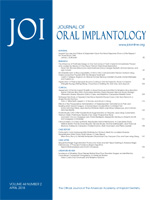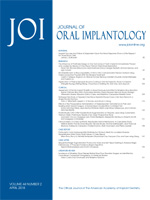
Journal of Oral Implantology Volume 47 Issue 1
Establishing a technique for SM perforation repair is essential because if SFA and implant placement are conducted without SM repair, or if the SM repair is done poorly, patients can experience various complications that could lead to infection and ultimately implant loss.
LAWRENCE, Kan. (PRWEB)
March 23, 2021
Journal of Oral Implantology – For successful dental implant surgery, patients need to have adequate bone volume in their sinus, the large cavity above the teeth, to support implants. Sinus floor augmentation (SFA) is a procedure that increases the amount of bone in this area through bone grafts. However, due to operator error or various pathologies, perforation of the Schneiderian membrane (SM), the lining of the sinus cavity, is a common complication, with prevalence as high as 56 percent. Small perforations can be closed without issue, but repairing large SM perforations can be more complicated. Techniques have been proposed to fix these large perforations, but none are officially recognized. A recent research article in the Journal of Oral Implantology conducted a long-term case series of patients with large SM perforations who were treated and received dental rehabilitation with implants.
Researchers from several universities in Brazil evaluated nine patients (five males and four females) who needed SM perforation repair followed by SFA before dental implant surgery. SM perforation repair was done using leukocyte-platelet rich fibrin (L-PRF) membranes, which involved drawing blood from the patient and isolating specific factors in the blood that were reintroduced on top of the SM perforation. After, the area was treated with bone graft material and covered with a collagen membrane. Patients healed for 8 months and were all determined to have an adequate bone volume for implant placement. The authors evaluated the success of the surgeries in these patients after 3 to 5 years by using cone beam computed tomography or panoramic radiography. This long-term assessment revealed that in all patients, large SM perforation repair was successful, all bone grafts and implants were retained, and no infection was present.
In addition to the treatment being successful overall, the authors highlight several other benefits to using L-PRF. L-PRF releases proteins and growth factors that encourage healing, decrease healing time, and prevent infection by boosting the immune response. Additionally, L-PRF is a naturally adhesive, affordable procedure that is derived from a patient’s own blood, essentially eliminating the possibility of rejection or allergic reaction.
This case series that includes 3 to 5 years of follow-up provides more evidence for the long-term success of using L-PRF membranes to repair large SM perforations. Establishing a technique for SM perforation repair is essential because if SFA and implant placement are conducted without SM repair, or if the SM repair is done poorly, patients can experience various complications that could lead to infection and ultimately implant loss.
Full text of the article “The Effectiveness of L-PRF in the Treatment of Schneiderian Membrane Large Perforations: Long-Term Follow-Up of a Case Series,” Journal of Oral Implantology, is available at https://doi.org/10.1563/aaid-joi-D-20-00044.
About the Journal of Oral Implantology
The Journal of Oral Implantology is the official publication of the American Academy of Implant Dentistry and of the American Academy of Implant Prosthodontics. It is dedicated to providing valuable information to general dentists, oral surgeons, prosthodontists, periodontists, scientists, clinicians, laboratory owners and technicians, manufacturers, and educators. The JOI distinguishes itself as the first and oldest journal in the world devoted exclusively to implant dentistry. For more information about the journal or the society, please visit http://www.joionline.org.
Share article on social media or email:

